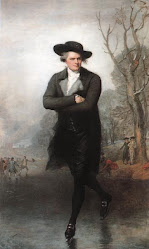Carrie moved to Fresno Ca after she married Lewis Cory who was born in San Jose Ca in 1861. The two were formally married in New York City in Oct of 1882. The Cory family was established in New Jersey before later descendents (Dr. Ben Cory) took the trek across the plains and established his practice in the Pueblo of San Jose in late 1847 (just before gold was discovered).
Now one of my readers has begun an exciting project, after seeing photos of my gt grandmother (scroll down to see the photos, and click here for more on Carrie.) She is attempting to paint this descendant of the Meeker twins in the style of Gilbert Stuart. What a fascinating idea, and this piece of artwork will be posted when it is finished! Just below is the latest email from Jeanne, who provides technical details about the work in progress. For those of you who love GS, or who love portrait painting for that matter, read on!
At the end of this post, you can view the GS portrait of Sally [Foster] Otis that Jeanne references. It is truely the work of a master. Stuart painted other Otis family members so I will post more information and other portraits of her family in the near future.
For me, this project is a special one; and I can only point to my Gilbert Stuart blog, for having a reader bless my ancestor with a portrait. I'm sure that Carrie would be highly pleased. Her life as a housewife [albeit wealthy housewife] in Fresno Ca was probably not as exciting as the life of the Meeker twins in early Philadelphia at the turn of the century. Although Fresno at the time was supposed to be the next San Francisco....
FROM JEANNE:
Although Stuart would have used the "sight-size" method of developing his likenesses, we don't have the luxury of Carrie sitting in person. What we have is two somewhat blurry photos (they are still a whole lot better than similar photos from my own family). In a case like this, the way I get a likeness is to enlarge the photo(s) to full size and make a careful tracing on clear acetate. I transfer the outline to the painting surface, which in this case is a gessoed panel. I keep the acetate tracing taped to the side of the panel during painting so I can periodically flip it over the painting to check for accuracy. So I know that Carrie's image is a true one.
The photo I traced was the hatless one, because it shows her forehead and hair. When that photo was enlarged, it was just barely possible to locate and draw the correct contours of her eyes, especially the lower lids. What initially appeared to be outer edges of her lower eyelids in the photo are actually their shadows. The eyelids themselves are shaped as you would expect from their appearance in the other photo. In addition, she had very excellent bone structure with a strong brow ridge. My older daughter has the same feature, and when she is photographed outside in bright sunlight, her eyebrows disappear. That is what happened to the outer portions of Carrie's brows in the first photo, so I did have to shape them as they appear in the second photo. Between those two refinements to the photo, her appearance is somewhat different than you will have expected. I think she looks quite pretty.
As I had mentioned in earlier email, the light source in the photo was not as perfect as I had originally thought. Looking through Stuart's work (and that of other artists too, like Reynolds for example), I have discovered that nearly all of them have the light source on the "near" side of the subject's face, illuminating the shape of the nose so that the shadow of the nose is on the "far" side of the face. Among the few exceptions to this in Stuart;s work are his Jefferson portraits. So I had to find a Stuart painting with a female sitter to use as a model for the shading on Carrie's face. There are not many good closeup photos of Stuart's portraits, which is sort of odd I think. But I did find the portrait of Sally Otis at the Reynolda House website, and I am using that as a guide for shading and color.
As you can guess, I am having a lot of fun with it all, and learning a few tricks as well. Today, I'm going to start on the lace blouse, which will probably bring its own challenges.
~~~~~~~~~~~~~~~~~~~~~~~~~
Jeanne mentions the Stuart portrait of Sally Otis, so I thought it would be interesting to include her portrait in this post. The portrait descended through family members, and was acquired by the Reynolda House from Vose Galleries in Boston in 1967.








